Performance Retrospective: AMD’s Radeon HD 7970M
by Jarred Walton on June 21, 2013 5:25 PM ESTValue/Medium 1366x768 Gaming Performance
We’ll start off with our “Value” settings, which consist of 1366x768 resolution and roughly Medium detail settings in the tested titles. This represents the sort of settings you’d be likely to use on an iGPU like the HD 7660G or Intel’s HD 4000 (maybe—HD 4600 is possibly a better bet) to get a reasonable >30 FPS out of most titles. Several of the games we’re using now are quite demanding, however, so iGPUs may not be able to provide an acceptable experience unless you really turn down the details and resolution. Here’s what performance looks like:
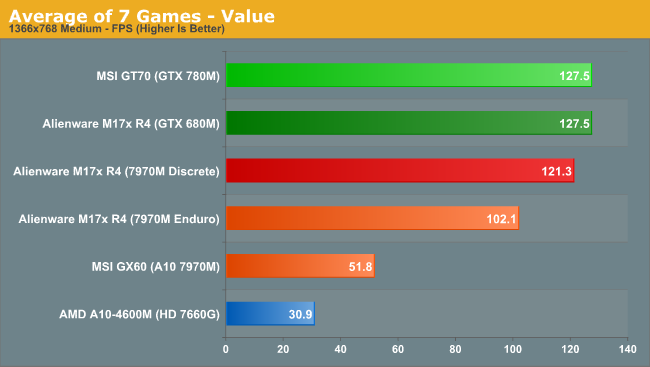

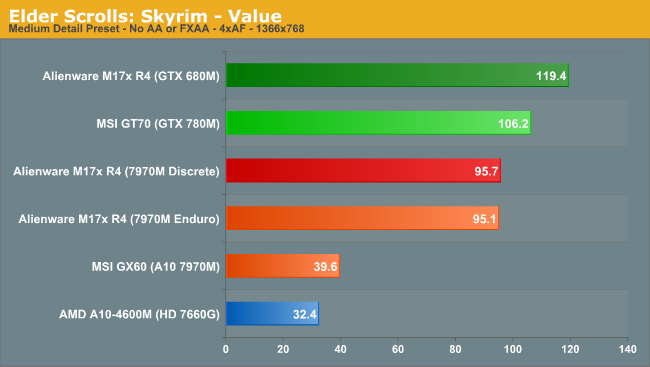

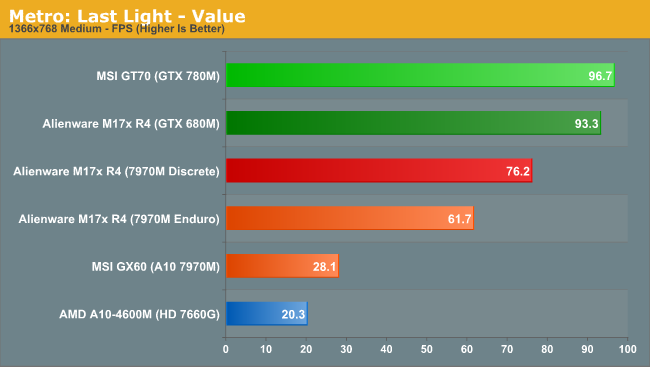

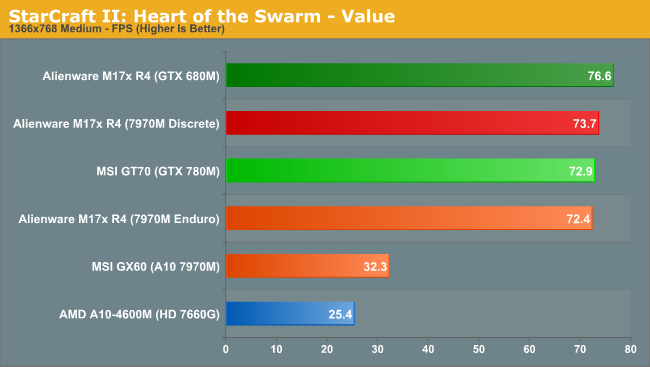
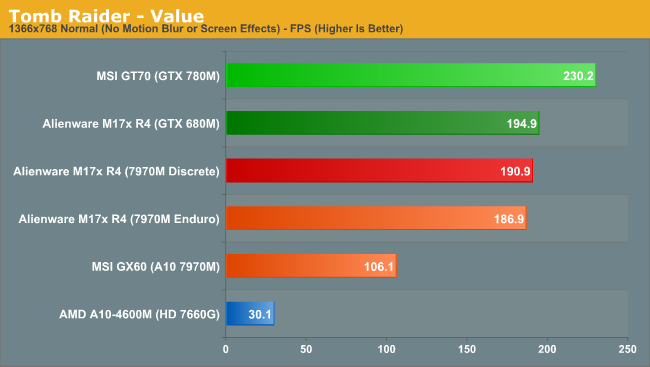
When the HD 7970M first hit notebooks over a year ago, the performance potential seemed lacking compared to the actual hardware. Based on the desktop Pitcairn core, HD 7970M should provide roughly the same performance as the desktop HD 7870 (it’s clocked 15% lower than 7870 on the core, though, so it’s closer to the HD 7850 and GTX 660). The reality is that where the HD 7850 typically competes well against NVIDIA’s desktop GTX 660, on laptops the GTX 680M often blasted the HD 7970M at launch. Many pointed to Enduro as a primary culprit, and while the situation has improved over the past 12 months, even now we can still see a periodic performance deficit from Enduro.
Going over the specifics, on the M17x R4 the discrete mode 7970M ends up being 24% faster in Bioshock, tied in Skyrim, 43% faster in GRID 2, 24% faster in Metro, 54% faster in Sleeping Dogs, tied in StarCraft II, and tied in Tomb Raider. The deficit largely exists in situations where you’re getting >60 FPS, e.g. at lower detail settings and a lower resolution, but that’s obviously not the only factor as Tomb Raider basically elicits no penalty and yet runs at over 180 FPS. While I don’t have the ability to do comparable testing with NVIDIA’s Optimus, I know at one point there were instances where Optimus was slower, but those issues have largely been fixed as far as I can tell. On AMD’s Enduro, that’s clearly not the case with the latest beta drivers.
Incidentally, the bandwidth used to shuttle frames over to the system RAM for display by the iGPU shouldn’t be a limiting factor. Consider as an extreme example a simple graphics benchmark like 3DMark03, where the Wings of Fury test can easily hit >500 FPS at 1366x768. That works out to roughly 2GBps of bandwidth over the PCIe bus, but an x16 slot offers far more bandwidth than that so 2GBps to transfer fames to system RAM shouldn’t present a problem. With the resolutions and frame rates we’re looking at here (a maximum of 1366x768 at <200 FPS), transferring the frames to system RAM uses just 840MBps, so that shouldn’t be a bottleneck.
Moving on to the Intel i7 vs. AMD A10 match up, things are actually worse. We can’t disable Enduro on the GX60, so we’ll just compare Enduro scores for the GX60 and M17x. The Intel platform in this case comes out 79% faster in Bioshock, 140% faster in Skyrim, 85% faster in GRID 2, 120% faster in Metro, 124% faster in Sleeping Dogs, 124% faster in StarCraft II, and 76% faster in Tomb Raider. On average, that works out to a margin of victory of 97%—basically twice as fast. Also of note is that on the GX60, the 7970M is only outperforming the integrated 7660G by 67% on average, so clearly there are other bottlenecks coming into play.
Figuring it was possible the single fan cooling setup in the GX60 is preventing the APU from hitting higher Turbo Core speeds, I logged the various clock speeds using HWiNFO64 and ran through the Bioshock Infinite and Skyrim (extended duration) benchmarks. Maximum CPU clocks reported throughout testing were at a steady 2.7GHz; the APU definitely didn’t hit maximum Turbo Core, but that's only for single-threaded workloads and the 2.7GHz clock is for two or more threads; regardless, it’s not running at the base 2.3GHz, so Turbo or throttling isn't the problem. Similarly, APU temperatures remained below 70C throughout testing, so cooling isn’t limiting performance either. Richland is supposed to be better about hitting its maximum turbo speeds, so potentially that alone could enable it to be 10-15% faster in games like Skyrim and StarCraft II, but the 2-thread turbo speed of Richland is probably similar to Trinity so the gain could prove to be less than 5%. GPU utilization of the HD 7970M during these tests was also rather low at around 35-55%, which isn’t all that uncommon at lower detail settings when the GPU isn’t being pushed hard. Whatever the cause, the fact is that at medium detail settings in most games, the A10-4600M (possibly in combination with Enduro) appears to be a bottleneck on the HD 7970M’s performance.
Wrapping up our look at the Value/Medium settings, if we compare NVIDIA vs. AMD there’s not a lot to say. At these settings, the 680M, 7970M, and 780M are basically taking a siesta. On average, the 680M ends up 5% faster than the best 7970M result and the 780M is tied with the 680M. Looking at individual game results there’s a bit more variation, however. Against the 680M, the 7970M (discrete mode) is generally quite close, with AMD getting minor victories in Bioshock and Sleeping Dogs; minor losses in GRID 2, StarCraft II, and Tomb Raider; and larger 20-25% losses in Skyrim and Metro. The GTX 780M numbers aren't too meaningful, thanks to the test system issues, but Tomb Raider immediately stands out as a game that does't appear to hit the CPU much at all.The 780M is actually slower than the 680M in some of the tests, but it does pull off a 21% lead over the 7970M in Tomb Raider—a game that tends to be very GPU intensive and very light on the CPU.










58 Comments
View All Comments
huaxshin - Monday, June 24, 2013 - link
Once again you guys at Anandtech come out as pretty clueless about the mobile hardware.First of all, thank you for confirming that its the APU that is the real culprint in the sometime bad performance in the GX60 system. That was all I wanted.
However what you are trying to do next, BLAME an OEM for this is just pathetic. You`re not seeing the big picture in this at all. Yes the GX60 may sometimes be as low as a system with i7 and a GTX 660M. But I can name many games where the 7970M+APU is miles ahead of the GTX 660M: Far Cry 3, Hitman, Black Ops 2, Sleeping Dogs, DarkSiders 2, World of Tanks etc.
MSI offer the GX60 way lower than a system with GTX 680M+i7. In fact its pretty much priced to where a GTX 660M is. So for those who are informed, its a no brainer to pick the GX60 system there. Now, you may be excused to not know this since you have never put 660M and GX60 against each other, but please try to be a little more humble next time.
Its quite sad that you attack MSI for being the only OEM to offer a cheap notebook with a performance like this. They should be rewarded, not criticized.
And please don`t dig yourself further down by calling people a fanboy. As a reviewer who post news and reviews on this site, you should know better than that. I thoroughly enjoy all your articles about new technology and how they work, and you guys are one of the leaders here, among the hundreds of reviewer sites. I own both Asus, MSI and Alienware notebooks thank you, so I`m no fanboy. I just react when I see reviews that are based on faulty devices, represented as the truth, when you and me both know that you guys recieved a melon from MSI. Is MSI at fault here for not doing better quality control on the paste job? Absolutely. But don`t write a review representing that as something that is perfectly normal. Anyone knows that 98C on the CPU is very wrong, even in one of those cramped up systems that is extremely thin that features a GTX GPU.
I had a pretty bad paste job on my GT70 too. In my GT70 they went pretty overboard with the pasting on the GTX 680M. :P http://i.imgur.com/JeDyF.jpg
http://i.imgur.com/plLzy.jpg
But repasting it was a 5 minute job.)
APassingMe - Monday, June 24, 2013 - link
I think the point being made here is that users are assuming that they will get the full benefit of the higher end gpu while in actuality they won't as a side affect of the cpu platform.And the actual issue is that MSI should be open about this or they should drop a lower end gpu in the laptop that is paired for the slower cpu speeds and reduce the end user's price while providing similar performance or they should offer a recommended cpu upgrade to remove/lessen the bottleneck while keeping the consumer informed...
Disclaimer... I am to some degree a fan of MSI, mainly due to their pricing so.... please take this as it is.
Bob Todd - Monday, June 24, 2013 - link
Pretty succinct summary. The GX60 basically needs a big sticker on the box that says "If you aren't GPU bound you are screwed!" The price point is great for a 7970m. However I think I'd rather take a chance of SLI not working for a particular game until drivers catch up with the Lenovo Y500 (IVB quad) for the same money, rather than worry about CPU potentially bottlenecking me in every single game. I won't even get into the horrendous abortion of design and material choices that MSI brings to the table with every laptop. When even Acer is cranking out nicer designs than you, something has gone horribly wrong.JarredWalton - Monday, June 24, 2013 - link
Sorry, but you're clearly the one that's clueless. No one is talking about i7+680M levels of performance here; I have numbers and the GX60 loses to the GE40 in many performance tests. Where it doesn't lose we're already often at non-playable frame rates (<30). Bioshock and Tomb Raider are the best showings for the GX60, and both are known for being very light on the CPU. Sleeping Dogs is marginally faster (32FPS vs. 26FPS), but at our High settings the GE40 ends up being nearly twice as fast. StarCraft II and Skyrim basically don't reach playable frame rates on the GX60, but on the GE40 at our max detail settings we get 42FPS and 44FPS (vs. 25 and 24FPS). So sure, any game that only requires GPU and hardly touches the APU may do well enough, but that's not exactly a large market.What's more damning to MSI is that the GX60 can't run four of our seven games at High settings at more than 40FPS (which is really what we want, as 30FPS average means dips into the low 20s and even teens), and at our Ultra settings it doesn't average more than 40FPS in a single title that we tested. The same GPU in the M17x only fails to break 40FPS at our max settings in two games: Metro: Last Light and Tomb Raider (and it's very close in TR).
On the other hand, thanks for confirming that you own an MSI laptop and apparently anyone dissing the company needs to be taken to task by you. Care to take pictures of your ASUS, MSI, and Alienware laptops all next to each other? The only one digging holes here is you, and you still don't understand that MSI's GX60 is not a good pairing of CPU/APU and dGPU. Funny that you seem to think a bunch of games run better on the GX60 than on other comparably priced alternatives, but to show that you turn to... GTX 660M, which really isn't worthy of the GTX name and we've said as much.
It's not that we received one melon from MSI, it's that they have a habit of delivering questionable hardware/designs on their laptops. Every single one has at least a few red flags for me -- keyboard, build quality, cooling, LCD, styling, etc. Even if the GT70 were performing up to par, the design is still woefully outdated. The fact that they ship out lemons to reviewers on the other hand is enough to sully their QA department to the point where we are far more comfortable recommending people not buy the GT70 from them.
JarredWalton - Monday, June 24, 2013 - link
By the way, Cloudfire from the NotebookReview forums, it's nice of you to criticize our review and suggest others do the same when you actually own a GT70 with Ivy Bridge and GTX 680M. Hmmmm.... Way to try and start something when you don't actually have any personal experience with the product. But hey, feel free to reapply thermal paste to your CPU/GPU in your notebook every six months, because that's what everyone should do!I've taken the time to look around and see what I can find on comparable gaming tests for the Haswell GT70 Dragon Edition. Oddly enough, I can't find anyone that has results that are directly in contrast to our review. One site has WoW Ultra figures with the Haswell system, and an M17x R4 with GTX 680M beats it by 40% at 1080p. They also measured 38.7 using the Tomb Raider Ultimate 1080p setting, which is actually WORSE than our result (which was already lower than GTX 680M). http://www.laptopmag.com/reviews/laptops/msi-gt70-...
Even Engadget, which isn't known for digging into performance all that much, has at least some numbers that go along with our results. Skyrim at 75FPS is still slower than the 77FPS we got with 680M, and our test in Skyrim tends to be far more demanding than what most others use (since it's FRAPS-based). http://www.engadget.com/2013/06/01/msi-gt70-dragon... Another site shows 58FPS in GRID 2 as well, thought potentially at 8xMSAA that might be part of the bottleneck.
And beyond those sites, I'm failing to find any real reviews of the Haswell GT70 Dragon right now. So you tell me, Cloudfire: is our unit truly a lemon, or did MSI screw up and not account for differences in cooling requirements from Haswell? Or maybe it's just BIOS and firmware stuff again. Whatever the case, I have no doubt that other GTX 780M notebooks will perform better, but without BIOS updates (or tearing it apart to apply better thermal grease and maybe put in a higher power fan?) I will be surprised to see the GT70 actually reach its full performance potential.
huaxshin - Monday, June 24, 2013 - link
There so many things here to respond to, which are plain wrong.Seriously stop quoting laptopmag and engadget. They dont offer any real analysis in any of their reviews other than scratching the surface.
Like I said many times now JarredWalton, go read the GT70 review on NotebookCheck. Its the -exact- same notebook as you "reviewed", with the exact same hardware.
They found zero performace issues with the CPU or the GPU compared to their GTX 780M review. They had MAX 92C on the CPU when running Furnark, far more demanding than the 3 hour gaming test you guys did. Yet it ran cooler.
So their review is in direct contrast to your review which couldn't be further from the truth. Notebookcheck found NO game where the GTX 680M beat GTX 780M.
This is exactly why Im saying you should try to act a little more humble when critique is presented. Your review is just wrong.
I see you have been visiting my profile at NBR. I see you read my recent tip about repasting. Any real gaming enthusiast knows that a repasting every 6 months along with blowing out the dust is only good for your system. Thats a given no matter what system you own. So yeah, since you didnt know: that is what everyone should do ;)
And yes I compared a system with GTX 660M against GX60. Because in average over 18 games from the GX60 review on Notebookcheck, those two systems actually perfom equally. Price wise they should also be compared because there are no system with higher end that is as cheap as the GX60. Which is what the notebook is all about: performance/price.
Go read the review Jarred. Don't look at 900p with high settings where the CPU is more at play. Look at the 1080p with settings vramped up. There you will see that its a good choice to pick GX60 ahead of a system with GTX 660M or pick GX60 instead of a higher end GPU since the GX60 is cheap and it will shine in the games I mentioned earlier.
huaxshin - Monday, June 24, 2013 - link
@JarredWalton:You should keep an eye out for the recent thread "calling all GT70 OD owners" on the MSI subforum. Hopefully we will see some data there from real owners soon ;)
I cant link to the thread here but since you apparantly like to stalk me, Im sure you will find it
JarredWalton - Monday, June 24, 2013 - link
Sure, they're using the "exact same notebook", except it was done with the non-Dragon version, which means likely a different assembly line (optimized to just produce that one SKU), possibly a different BIOS, possibly different thermal paste.... The reality is that we don't know exactly what they tested vs. what we tested, but go ahead and assume all you want since you're good at that. We know the MSI GT70 Dragon we tested performed poorly, and the only two other sites I can find that definitely tested the new Dragon Haswell model corroborate at least some of our results. But you discount Engadget because "they don't do any real analysis" -- how hard is it to run the built-in benchmark from GRID 2 at Ultra settings?You might want to grab a dictionary. A stalker is someone that harasses or persecutes someone with unwanted and obsessive attention. I work for AnandTech, so I "live" here while you're coming here as a guest and obsessing over a review that was not favorable. Why wasn't it favorable? Because the CPU throttled and killed performance. It doesn't really matter what the precise cause of that problem is; the fact it that it happened, and that's not acceptable, and we said as much in the review.
In response, you created a new user account to post inflammatory comments, and you have posted about 20 comments in two articles all of a similar nature, not to mention asking others to come to your aid and add to the harassment. (What was wrong with the Cloudfire or Cloudfire777 names?) Anyway, sorry to tell you but you're the perfect description of a troll and an online stalker.
As for your quest to prove us "wrong", so far you've got one person saying, "I applied better thermal paste and it helped temperatures." That basically just confirms that MSI is not testing/QA'ing their products well, or they would have switched internally already. Tell you what, though: let me pay you a flat fee for reviewing a product, then tell you to go back and put on new thermal paste and retest everything without getting paid any extra. Sound like a good deal for Dustin to do the QA for notebooks, or shall we just take what they send and see how it performs?
Now, to try to feel better about yourself, you again bring up GTX 660M. That's just a GK107 part at slightly higher clocks, and no one really cares. GTX 760M is a completely different beast and you can get that for $100 more than the GX60. It's only faster in two games at Ultra settings, but the GX60 only handles about half of the games at Ultra settings to begin with. So you drop down to High settings and the GE40 is faster in four of the seven games and tied in one. But then there's also the GE60 that has the same size LCD and a GTX 765M for the same $1200. 765M is clocked almost 30% higher on the cores, meaning the performance difference is likely to be even more in favor of the NVIDIA card. That's of course assuming none of these parts have crappy thermal paste I suppose.
So far, I think we can agree that:
1) The GX60 is only good for certain games, because of APU/driver/Enduro/other bottlenecks.
2) The GT70 Dragon (Haswell + 780M) appears to have a bad factory thermal paste application.
3) Build quality and design on both of the above laptops is, at best, lacking.
4) We wouldn't recommend either laptop without serious qualifiers (e.g. be willing to replace thermal paste on the GT70 -- hey, it's only a $2800 notebook; what did you expect?)
Did I miss anything in that summary? Is any of the above not made clear in the text of the articles?
huaxshin - Tuesday, June 25, 2013 - link
Now we are getting somewhere.1. Time to stop with the silly excuses. The only reason why GX60 doesn`t perform, is because of the APU. Enduro only counts for maybe 5% like you posted in this review. Not 34% less than 7970M systems. That is as clear as the sun, and this is what I have been trying to drag out of you from the moment this discussion began. Its not the notebook or silly things like drivers, because ANY notebook with 4600M and 7970M would have acted equally poorly.
2. YOUR GT70 Dragon have bad paste. I can`t comment on the other ones since I haven`t seen any other good tests with temperature measurements on the CPU or GPU. Just a IR meter measurement on the top of the keyboard and thats it. Like I said, just scratched the surface.
3. Build Quality is at best lacking? Lets see here: Dynaudio, best speakers on the market for notebooks. Semi mechanical keyboard with way better feedback than the majority of keyboards out there. Raid0 card that can take 3 mSATA SSDs and Raid them together. Only OEM that offer it. Programmable fan speed through access editing the firmware. Again, pretty much the only OEM that have this opportunity. Aluminum on lid and palm rest, while most OEMs have plastic fantastic. Again, its sad to see you guys jump on MSI just because you recieved one notebook with bad paste job.
4. GT70 is $1999 thank you. And why do you assume ALL GT70 have bad paste job Notebookcheck didn`t. Sweclockers didnt...
Additional point:
5. The cooling system inside your Dragon Editon is identical with the one Notebookcheck used. Same amount of heatsinks, same heat pipes, both have heatsink between CPU and GPU.
So what does that mean when Notebookcheck got much better temperatures than you guys?
They didn`t get a lemon with bad paste job.
There is no point trying to find excuses. Thats the only explanation.
6. So you guys wouldn`t redo the review because you aren`t paid enough? I crave for technology like this. I wouldn`t mind to redo a few benchmarks with a new paste job. The repaste itself takes like 5 minutes to do. You wouldn`t have to redo all the game tests either, you could have just done the 3 hour gaming session, logged the temperature, and if it was better, edited the review you posted.
JarredWalton - Tuesday, June 25, 2013 - link
Build quality is different than features. Three mSATA drives in RAID 0? Why? A single good SSD is better in most cases, or if you need more performance than do RAID 0 of two drives and use M.2, not the now-deprecated mSATA. This is purely marketing gee-whiz stuff. Programmable fan controller is something every system has, but they don't expose it to the end users in most cases. If the cooling works properly, there's no need to do so. Aluminum veneers on the palm rests is not the same as a solid non-plastic construction, and black aluminum is getting old -- it shows fingerprints and grease far too much. Straight silver (like the ASUS UX series or Apple) is so much better long-term.Now, I don't think Clevo units are built all that well, but they're comparable in most regards to the MSI. The Alienware M17x on the other hand is definitely built better -- not necessarily perfect by any means, but I do prefer it. Not sure if the new 17 is any different -- I would change the display hinge at the very least, and give it a matte panel. And please no touchscreens! Ugh... fingerprints on 17" displays suck to clean off. But I digress....
You're still missing the point on the thermal paste/testing. Just because all of the components are the same in the various new GT70 models doesn't mean they all come off the same assembly line. The Dragon SKU is likely a special line where there are no custom options: it's all the same parts, every time. Maybe the problem is in that particular line, and they don't apply the TIM properly. The $2000 models don't have all the extras that the Dragon has, so basically they have unused expansion options for the future.
We are going to see if we can get a second unit for retesting (or if Dustin still has this one, either he or I will investigate the TIM question). If problems persist, then we will definitely request a new notebook.
Finally, regarding the Enduro question, it's obvious that there's some overhead with Enduro, and very possibly it's CPU overhead as well as other aspects. The drivers have to do more work to transfer frames to the iGPU framebuffer, if nothing else. Just because the M17x doesn't have lower Enduro performance at max detail settings doesn't mean the same is true of the GX60. We are going to see about simulating the A10-4600M at 2.7GHz with an 850MHz/4800MHz HD 7870 desktop setup, which will remove Enduro from the equation. Want to make a wager that performance is at least 20% higher than on the GX60? It won't be happening today or tomorrow, as we need to get all the proper parts with one reviewer, but we'll be investigating this in the future.